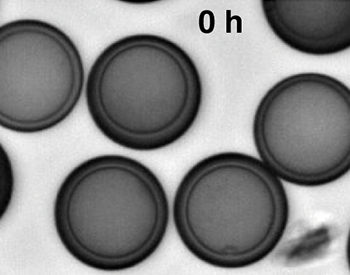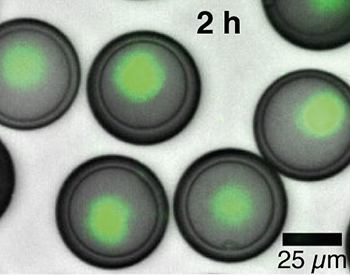Synthetic Cells Command New Powers of Communication
November 28, 2018 | By Cynthia Dillon
  |
GFP expression in cell-mimics. Image by Henrike Niederholtmeyer |
From kryptonite for Superman to plant toxins for Poison Ivy, chemical reactions within the body’s cells can be transformative. And, when it comes to transmuting cells, University of California San Diego researchers are becoming superhero-like copy cats.
Recent Blavatnik National Laureate in Chemistry Neal Devaraj, along with research colleagues Henrike Niederholtmeyer and Cynthia Chaggan, used materials like clay and plastic to create synthetic cells—or “cell-mimics”—capable of gene expression and communication rivaling that of living cells. According to some scientists, these research results, published this week in Nature Communications, could be among the most important in synthetic biology this year.
Scientists are hopeful about working with cell-mimics because they present potential for delivering drugs more precisely within the body, calling out cancer cells, locating toxic chemicals, and improving diagnostic testing. Interactive cell-mimics could even form artificial tissues. Scientists also anticipate that the very process of making synthetic cells could lead to a better understanding of life’s origins and evolution. But, there’s a catch.
“If we are going to develop synthetic materials, we need to have the individual units cooperate,” explained Devaraj, a professor in UC San Diego’s Department of Chemistry and Biochemistry.
Until now, cell-mimics have communicated somewhat by exchanging small molecules; for example sugar and hydrogen peroxide. Yet they could not talk to each other through large molecular protein signals because their membranes didn’t allow large molecules to cross. Communication through protein signals, however, is extremely important: Cells in our bodies signal to each other through proteins like insulin and growth factors.
To address this challenge in artificial cell synthesis, Devaraj and his team made microfluidic chips from a silicone polymer to push out droplets of DNA encoding green fluorescent protein (GFP), minerals from clay and precursors for acrylic plastic. Then, using ultraviolet light and chemicals, they triggered the formation of a spongy membrane around each droplet, while the DNA within each droplet condensed into a gel-like substance to create a neo-nucleus. The researchers also gave their cell-mimics the ability to synthesize proteins. Their methodology enabled transfer of information across the novel membrane. The result was a cell-mimic capable of sending protein signals to neighboring cells.
According to Niederholtmeyer, these talkative pseudo-cells, “look and behave like natural cells but they are made of completely artificial materials.” Other life-like qualities of the cell-mimics include quorum sensing—behavior changes among dense cells, task distribution and cellular differentiation according to local environment.
“We were surprised and excited that our cell-mimics could so accurately sense their density, meaning that they could sense how many neighbors they had, even though they were not in close contact with them,” said Niederholtmeyer. “That was surprising because the molecular network that led to the quorum sensing behavior in our cell-mimics is very different from how quorum sensing works in bacterial cells.”
Like superheroes, the synthetic cells are resilient, remaining intact for long periods of time after being frozen and even at ambient temperatures. This resiliency makes them ideal candidates for environmental sensors, an opportunity for future research by the UC San Diego scientists. Additionally, the stability and programmability of cell-mimics makes them exciting for other scientists as well.
“They are easy to share between research groups and can be programmed by DNA to express any RNA, protein or pathway,” added Niederholtmeyer.
According to the postdoctoral scholar, the results from the three-year study present many potential uses and ways to further develop these cell-mimics.
“For example, we have already been contacted by other researchers at UC San Diego, who would like to try to use materials from our cell-mimics in living cells to fight diseases. We are also interested in further developing the membrane, for example so that it can respond to stimuli and to make it more biologically active. Our cell-mimics are very programmable,” said Niederholtmeyer. “Another important advantage is that they are so stable, which will make sharing these cell-mimics in collaborative projects easy.”
At UC San Diego, our research efforts are designed to change the world for the better—through new medicines, innovative technologies and more that will help address disease, global security, public policy, climate change and more.
